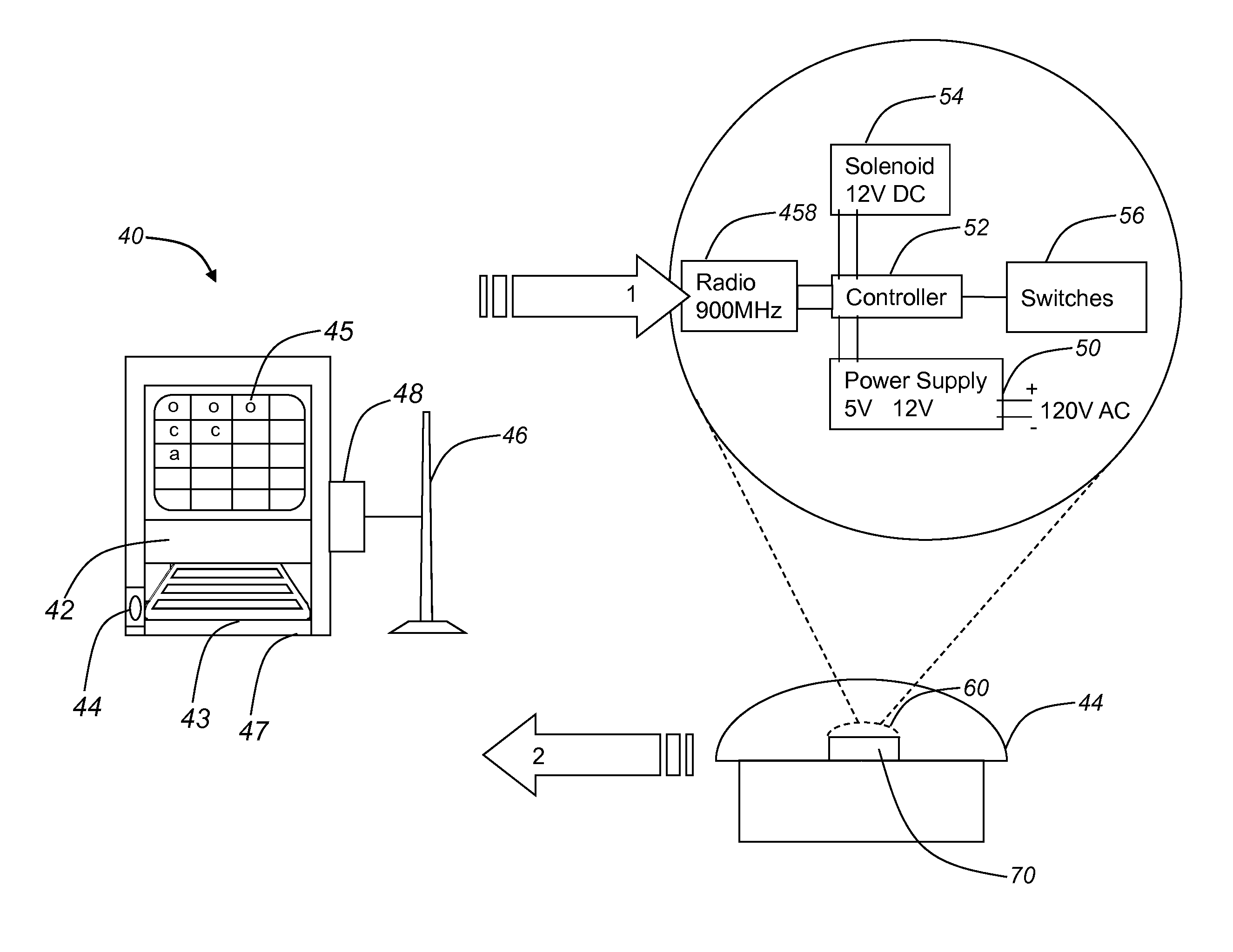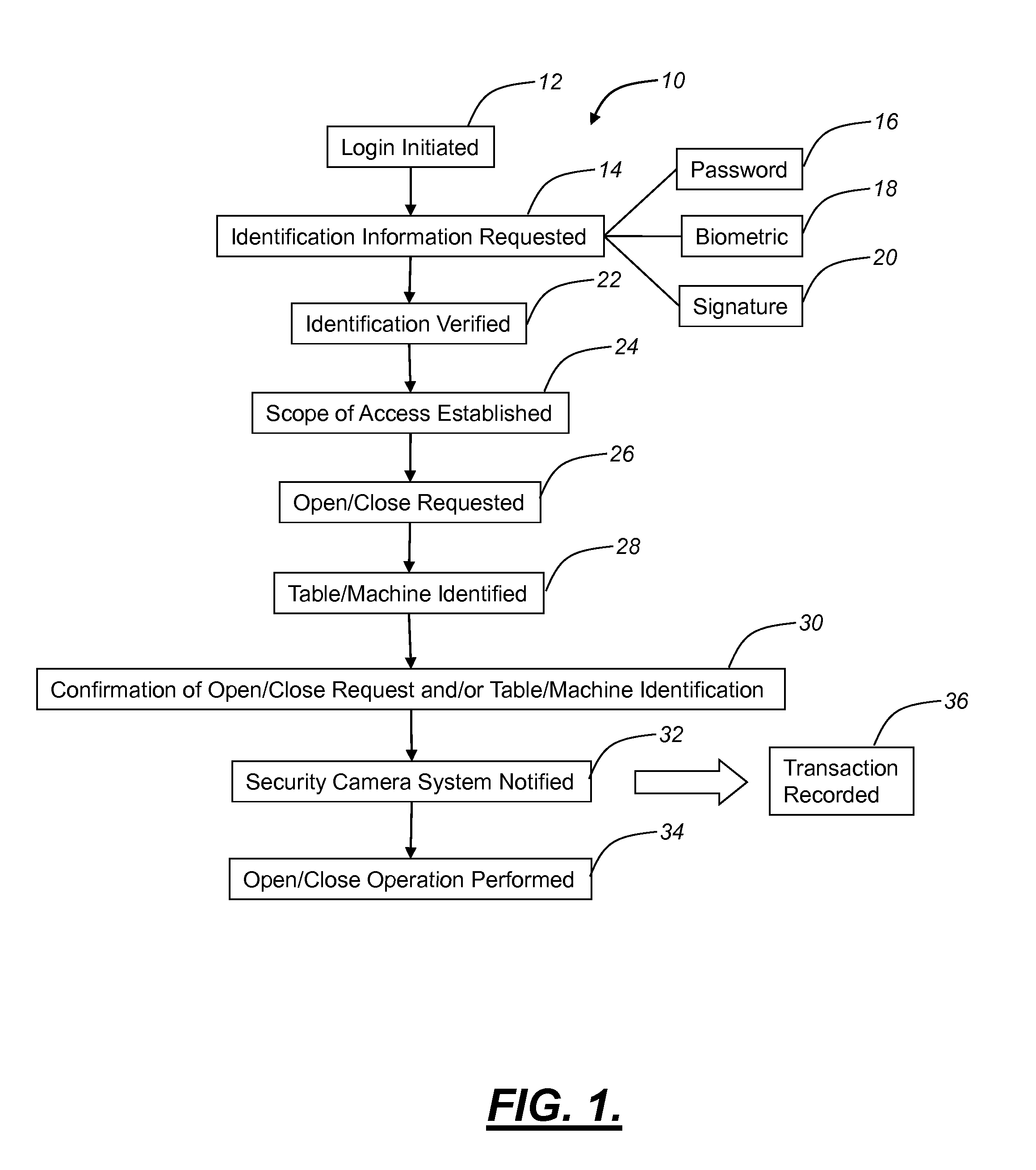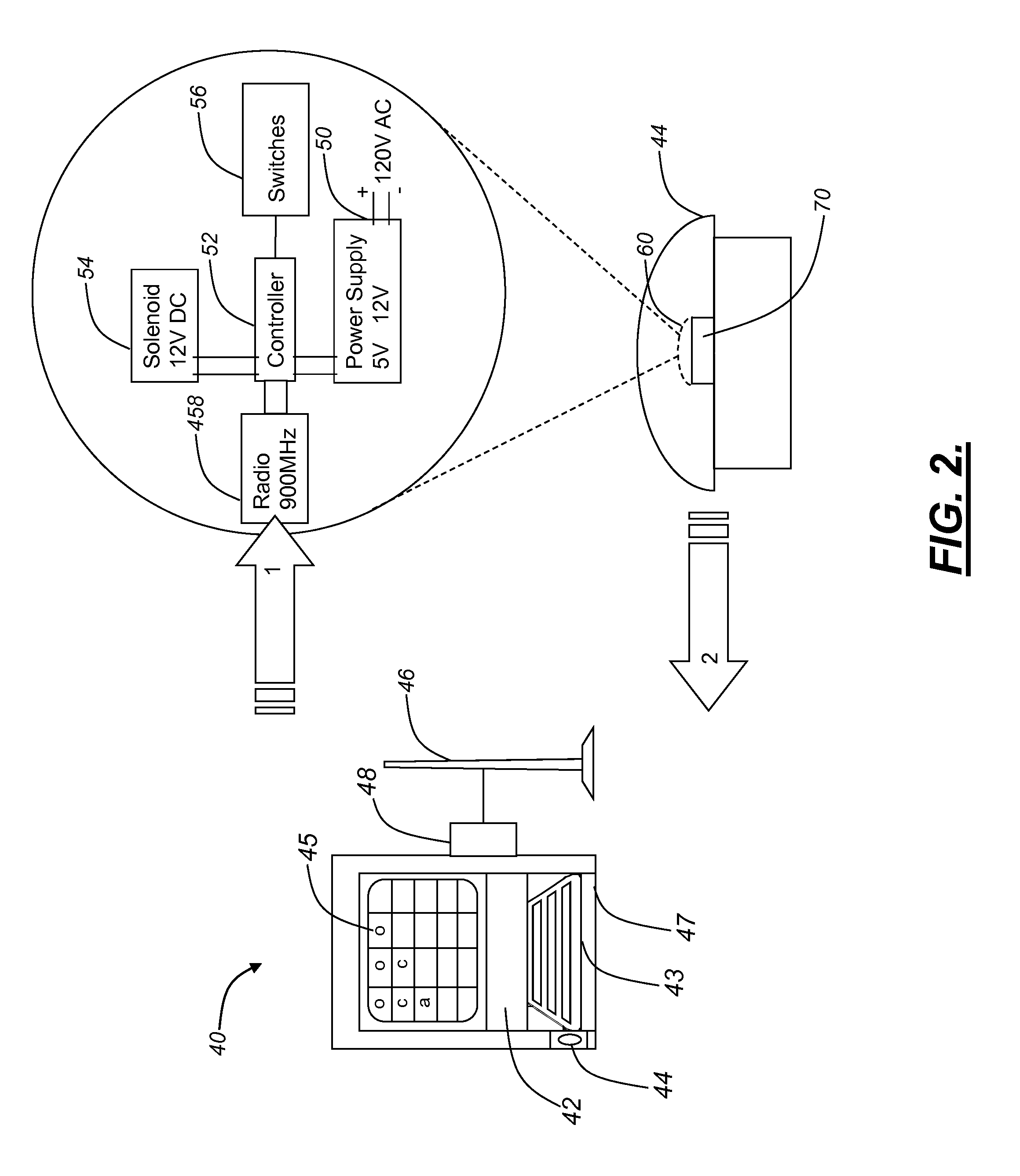[0008]The communications channel of the command kiosk and the communications channel of the security assembly communicate over an encrypted channel, such as a 56-bit dez encryption using frequency hopping spread spectrum radio frequency operating at 900 MHz or the like.
[0009]The algorithm authorizing the predetermined level of command control based upon the identity of the user utilizes at least three levels of access, user level, administrator level, and technician level, for example; and the lockable devices have levels of access, wherein the authorizing algorithm only permits an individual who has successfully logged in to change the status of the lockable device, from locked to unlocked or vice versa, and the individual must have as high or higher level of access than the lockable device's access level.
[0010]Furthermore, the present invention provides a method for selectively granting access to an asset. The method includes the steps of providing a lockable device coupled to and secured by a security assembly; providing a command kiosk with a processor remotely located from the lockable device executing one or more algorithms operable for identifying a user, authorizing a predetermined level of command control based upon the identity of the user, receiving a command from the user to provide access to the device to at least one of the user and a third party, and translating the command into a form that may be received by the security assembly; providing a communications channel operable for communicating the translated command to the security assembly; providing a controller proximately located to the lockable device executing one or more algorithms operable for actuating the security assembly in response to the translated command, thereby providing access to the lockable device to at least one of the user and a third party; logging in a user with a biometric scanner and confirming against a database of users, where each user has a biometric password and is assigned a level of access; selecting a lockable device and confirming against a database of lockable devices having a unique address and a level of access, that the user has as high or a higher level of access than the selected lockable device; assuming that the user has clearance, selecting at least one third party from a list; actuating a lock on a selected lockable device, or canceling to exit or start the process over; and recording all entries for possible later generation of a report.
[0011]It should be noted that the method is particularly suitable as a gaming method for selectively granting access. In such exemplary embodiment, the lockable device is selected from the group consisting of a tray disposed within a surface of a table, an apparatus disposed within a slot machine, and the like. In the case of a tray, there is a lid disposed over a top of the tray coupled with a selectively actuated latch assembly, and in the case of a slot machine there is a door disposed over an opening of the slot machine coupled with the selectively actuated latch assembly. The processor is further operable for receiving a command from the user to prevent access to the device for at least one of the users and a third party and translating the command into a form that may be received by the security assembly. After actuating the actuating a lock, the user is automatically logged out. Alternatively, the security assembly is only actuated temporarily, reverting to an initial state after a predetermined period of time.
[0012]In a more broad sense, in one exemplary embodiment, the present invention provides an automated asset management and security system for providing selective authorized access to an asset disposed within or associated with a remotely located lockable device, including: a control console, including: a processor executing one or more algorithms operable for identifying a user, authorizing a predetermined level of access based upon the identity of the user, receiving a command from the user to provide access to the asset disposed within or associated with the remotely located lockable device, and generating a corresponding command for the lockable device; and a communications channel for delivering the corresponding command to the lockable device; wherein the lockable device includes: a controller having a unique address executing one or more algorithms for implementing the corresponding command and implementing the translated command; and an actuation mechanism operable for selectively providing access to the asset disposed within or associated with the remotely located lockable device responsive to the corresponding command. The processor further executes one or more algorithms operable for identifying the user based on acquired biometric data. The processor further executes one or more algorithms operable for recording the identity of the user and the time and nature of the received command. Optionally, the communications channel is a wireless communications channel. Preferably, the lockable device further includes one or more switches operable for detecting the status of the lockable device in terms of whether or not the lockable device is in an access granted, access denied, or alert status. The processor further executes one or more algorithms operable for recording the detected status of the lockable device.
[0013]In a more broad sense, in another exemplary embodiment, the present invention provides an automated asset management and security method for providing selective authorized access to an asset disposed within or associated with a remotely located lockable device, including: providing a control console, including: a processor executing one or more algorithms operable for identifying a user, authorizing a predetermined level of access based upon the identity of the user, receiving a command from the user to provide access to the asset disposed within or associated with the remotely located lockable device, and generating a corresponding command for the lockable device; and a communications channel for delivering the corresponding command to the lockable device; wherein the lockable device includes: a controller having a unique address executing one or more algorithms for implementing the corresponding command and implementing the translated command; and an actuation mechanism operable for selectively providing access to the asset disposed within or associated with the remotely located lockable device responsive to the corresponding command. The processor further executes one or more algorithms operable for identifying the user based on acquired biometric data. The processor further executes one or more algorithms operable for recording the identity of the user and the time and nature of the received command. Optionally, the communications channel is a wireless communications channel. Preferably, the lockable device further includes one or more switches operable for detecting the status of the lockable device in terms of whether or not the lockable device is in an access granted, access denied, or alert status. The processor further executes one or more algorithms operable for recording the detected status of the lockable device.
 Login to View More
Login to View More  Login to View More
Login to View More 


